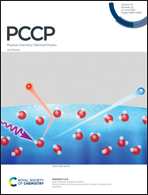Effects of self-hydrogen bonding among formamide molecules on the UCST-type liquid–liquid phase separation of binary solutions with imidazolium-based ionic liquid, [Cnmim][TFSI], studied by NMR, IR, MD simulations, and SANS†
Abstract
The upper critical solution temperature (UCST)-type liquid–liquid phase separation of imidazolium-based ionic liquids (ILs), 1-alkyl-3-methylimidazolium bis(trifluoromethanesulfonyl)imide ([Cnmim][TFSI], where n represents the alkyl chain length of the cation, n = 6, 8, 10, and 12) binary solutions with formamide (FA) was examined as a function of temperature and the FA mole fraction xFA. The two-phase region (immiscible region) of the solutions is much larger and expands more with the increase in n, in comparison with the previous [Cnmim][TFSI]–1,4-dioxane (1,4-DIO) systems. An array of spectroscopic techniques, including 1H and 13C NMR and IR combined with molecular dynamics (MD) simulations, was conducted on the present binary systems to clarify the microscopic interactions that contribute to the phase-separation mechanism. The hydrogen-bonding interactions of the imidazolium ring H atoms are more favorable with the O atoms of the FA molecules than with 1,4-DIO molecules, whereas the latter interact more favorably with the alkyl chain of the cation. Upon lowering the temperature, the FA molecules gradually self-aggregate through self-hydrogen bonding to form FA clusters. Concomitantly, clusters of ILs are formed via the electrostatic interaction between the counter ions and the dispersion force among the IL alkyl chains. Small-angle neutron scattering (SANS) experiments on the [C6mim][TFSI]–FA-d2 and [C8mim][TFSI]–FA-d2 systems revealed, similarly to [Cnmim][TFSI]–1,4-DIO systems, the crossover of the mechanism from the 3D-Ising mechanism around the UCST xFA to the mean-field mechanism at both sides of the mole fraction. Interestingly, the xFA range of the 3D-Ising mechanism for the FA systems is wider compared with the range of the 1,4-DIO systems. In this way, the self-hydrogen bonding among FA molecules most significantly governs the phase equilibria of the [Cnmim][TFSI]–FA systems.
![Graphical abstract: Effects of self-hydrogen bonding among formamide molecules on the UCST-type liquid–liquid phase separation of binary solutions with imidazolium-based ionic liquid, [Cnmim][TFSI], studied by NMR, IR, MD simulations, and SANS](/en/Image/Get?imageInfo.ImageType=GA&imageInfo.ImageIdentifier.ManuscriptID=D2CP01006B&imageInfo.ImageIdentifier.Year=2022)


 Please wait while we load your content...
Please wait while we load your content...